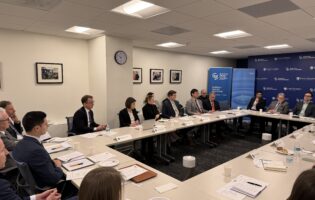A Comparative, Historical Study of Political Trajectories in U.S. Bilingual Education and Islamic Religious Instruction in Germany
AGI’s seminar on bilingual education in the United States and Islamic religious instruction in Germany with Dr. Girma Parris, DAAD/AGI research fellow, used several case studies from both countries to analyze how two factors, elites’ historic views toward the two policy areas and the relative closed or open-ness of the policymaking systems, to explain why policy trajectories in these two instances had taken on particular historical trajectories. Bilingual education and Islamic religious instruction were treated as two comparable areas of political incorporation and two issues in which contestations over each nation’s cultural identity were central to policy debates. These policies predominantly involve the incorporation of Spanish and Islam. Subsequently, Mexican-Americans and Turkish-Germans, who are the largest immigrant groups in each country (and who speak and practice Spanish and Islam, respectively), are leading advocates for bilingual education and Islamic studies. These issues subsequently involve their political incorporation.
Since the 1980s, historical policy trajectories in these issue areas seem counterintuitive. Policy trends in U.S. bilingual education at the state level in this period reveal policy roll-back. For Turkish-Germans, despite comparatively less political incorporation and a shorter immigration history, Islamic religious instruction (IRI) indicates moderate expansionary trajectories. This is counterintuitive, given the longer period of political incorporation and immigration (in general) for Mexican-Americans. Theories regarding the benefits of political entrenchment and immigration suggest that Mexican-Americans should be better positioned to attain their policy interests.
Using the cases of California and Texas, Dr. Parris then expanded on this argument. These two states were chosen according to the partisanship and degree of openness and closeness of the policymaking system (as the historical views of elites toward bilingual education are similar in the two states). California is politically left-leaning, so it is expected that bilingual education would be favorable there. Texas is right-leaning, with presumably less support for bilingual education. California has the more open policymaking system (because of the presence of the voter initiative as a policymaking mechanism) while Texas has the more closed policymaking system (as it lacks this policymaking feature).
From 1965 to 1975, there was elite support for bilingual education. From approximately 1978 on, however, there was elite division concerning bilingual education (with liberals favoring the pedagogical approach and conservatives opposing it). Similarly, from 1965 through the mid-1980s the policy trajectories in both states closely resembled one another, with each state experiencing substantial expansion of bilingual education arrangements. By the mid-1980s, differences in the policymaking systems had real influence on policy trajectories. Because Texas lacked the voter initiative (due to its closed policymaking system), entrenched Latino advocacy was able to mitigate and maintain bilingual education policy arrangements despite the increased political salience of anti-immigrant populism and English-only movements. These movements tried but failed to pass Official English legislation in the 1980s and English immersion legislation in the 1990s that would have replaced bilingual education policy arrangements (despite polls showing support among the electorate for both initiatives). In California, because of the presence of the voter initiative, anti-immigrant populism and English-only movements affected the policymaking process (tapping the anti-bilingualism sentiment in the electorate), leading to policy roll-back in bilingual education. The passage of Official English legislation (making English the official language of the state) led to the end of bilingual education law (mandating bilingual education) in 1987. The voter initiative in the mid-1990s would eventual result in the statutory end of the approach (making the use of bilingual education illegal) via Proposition 227 in 1998.
The German cases examined religious instruction in both western and eastern Germany from 1965 to 2010. The cases of North Rhine-Westphalia (NRW), Bavaria, and Berlin were selected according to differences in elite views concerning religious instruction as all of the German cases had closed, corporatist policymaking systems. The cases were also chosen according to differences in partisanship, with more left-leaning states expected to be more accommodating in expanding Islamic religious instruction. In both North Rhine-Westphalia (NRW) and Bavaria, there was elite support for religious instruction. In Berlin, due to the legacy of the German Democratic Republic, which opposed the church having more power than the state, there was ambivalence toward religious instruction. With respect to partisanship, NRW and Berlin were more left-leaning over the period of study and Bavaria was more right-leaning.
Dr. Parris found that NRW and Bavaria showed moderate, iterative policy expansion in Islamic religious instruction over the period of study (with initiatives in NRW beginning in the late 1970s and the mid-1980s in Bavaria). Because the two western cases had elite support, officials in NRW and Bavaria were more accommodating than Berlin and these similarities existed despite their partisan differences. The main issue in these corporatist systems in establishing religious instruction was finding and officially recognizing a Muslim religious community. In NRW and Bavaria, when state officials could not find a community to recognize, they employed extralegal arrangements to provide some semblance of Islamic religious instruction. In Berlin, when faced with a similar situation, officials chose not to employ extralegal mechanisms to provide some form of Islamic religious instruction. Nevertheless, because of increasing support in the German court system for Muslim recognition, a Muslim community, the Islamic Federation of Berlin, was able to successfully sue for official recognition in 2000. Nevertheless, Berlin officials were found to be less accommodating than the two western Bundesländer.
With respect to the German cases, partisan differences did not explain differences in policy outcome. Elite views concerning religious instruction was more explanatory. Elites in NRW and Bavaria viewed religious instruction positively and made accommodations to provided IRI. Berlin elites were more ambivalent and were subsequently not as accommodating.
In his final assessment, when comparing the two national settings, the American setting showed periods of dramatic expansion (1965-1975) and rollback (from 1978-2010) in bilingual education. In Texas rollback was moderate while in California, it was dramatic. The open policymaking system in the U.S. enabled dramatic policy change due to the interaction of policy venues at the local, state, and federal level. The changing of elite views from agreement to disagreement in the late 1970s led to the change from expansion to rollback. In California, because of the presence of the voter initiative, anti-immigrant populism was able to affect the policy process from the mid-1980s forward, leading to the statutory end of bilingual education in the state in 1998. In Texas, the politically entrenched Mexican-American advocacy network was able to use its favorable position in the policymaking network to thwart anti-populist initiatives to end bilingual education (despite conceding moderate rollback of bilingual education) in the 1980s and 1990s.
In Germany, elite support for Islamic religious instruction and Germany’s closed, corporatist setting led to moderate, iterative policy expansion over the period of study (and especially after from the 1990s forward). Elite support politically facilitated its continued expansion. The closed policymaking system precluded dramatic policy change, only permitting moderate expansion. However, the closed system did insulate the policymaking process from the political influence of anti-immigrant sentiment (also present among the German electorate).
Ultimately, when times were good for the pro-bilingual forces in the U.S., they were great. When the politics of bilingual education became less favorable, policy rollback occurred and could be quite substantial depending on the degree of openness of the state policymaking system (as was the case in California). For pro-Islamic religious instruction interests in Germany, elite support enabled continued moderate expansion. And this was more consistent in the western Bundesländer, which had elite support. However, due to the closed policymaking settings, and despite favorable political conditions, policy expansion was only moderate and iterative.
The American policymaking setting presents favorable opportunities for interests when elites favor expansion of their preferred policy arrangements. The multiple policy venues and the possibility for interaction can lead to a virtuous cycle where policy expansion in one venue leads to policy expansion in others. And this can facilitate substantial policy expansion. This system can also facilitate substantial and rapid contraction because of the same institutional dynamics. The porousness of the American policymaking system also makes it more plebiscitary, or responsive to the popular will. And for immigrant issues this is typically not a favorable context.
In the German system, rapid, substantial policy expansion is less likely because of the single venue policymaking structure of cooperative corporatism. However, the closed policymaking system insulates policymaking from the anti-immigrant politics. Combined with German elites’ more accommodating stance to issues of ethnic integration (because of the politics created from its history and in this case because of its historic support for religious instruction), this makes for a stable setting for moderately advancing immigrant integration initiatives slowly over time.
Location
AICGS
1755 Massachusetts Ave, NW Suite 700 Washington, DC 20036 United States







